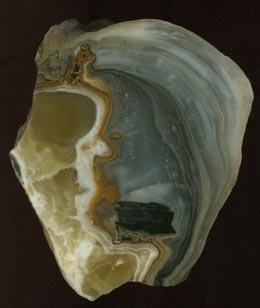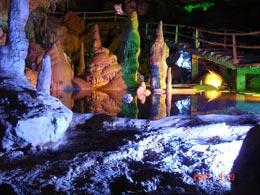 The stalagmite found in the Chinese cave is over 1,800 years oldScience
The stalagmite found in the Chinese cave is over 1,800 years oldScienceA 1,800-year-old stalagmite from a Chinese cave has revealed that, in the past, warmer years were associated with stronger East Asian monsoons. That was true until just 50 years ago, when the relationship broke down because of man-made greenhouse gas emissions and pollution. The researchers also suggest that weaker monsoons may have led to the demise of some Chinese dynasties, as water shortages and poor harvests triggered public unrest.
As a monsoon advances, water vapour containing the heavy oxygen isotope 18O is more likely to condense and fall as rain. So the stronger the monsoon, the less 18O clouds contain and the lower the 18O/16O ratio. Stalagmites hold a record of this because they are formed from dissolved minerals and the rain water as it drips through cracks in caves. Scientists can also date monsoons by measuring the decay of uranium-234 to thorium-230 in the stalagmites.
In May 2003, Zhang Pingzhong, a geologist at Lanzhou University in Gansu province, and his colleagues collected an 11.8-centimeter-long stalagmite column in Wanxiang Cave, located between the Tibetan plateau and Loess plateau, a region dominated by the East Asia monsoon.
"The sample is absolutely amazing," enthuses Zhang. "It had been growing continuously since 190AD, and contained an unusually high uranium concentration and few contaminants." This allowed the team to make detailed measurements of rainfall and date monsoons far more accurately than previous studies - with an error range of decades rather than centuries.
Reporting in Science1, the researchers show that the intensity of monsoons oscillated over the past two millennia, with heavier monsoons accompanying warmer years – as determined by solar activity and proxy temperature records from, for example, tree rings.
 View from inside Wanxiang CaveScience
View from inside Wanxiang CaveScience"However, this correlation has stopped since the 1960s," explains Zhang. "This may suggest that increasing levels of greenhouse gas emissions and atmospheric aerosols caused by human activities are making the monsoon weaker."
Being the biggest greenhouse gas emitter with one-fifth of the world's population, China certainly has cause for concern, Zhang adds. "The government should think hard about how to use water resources properly and try to restore the natural monsoon rhythm by cutting down pollution," he says.
Dynastic dangers
"This is worrying given the severe water shortage in China," says Hai Cheng, a geologist at the University of Minnesota in Minneapolis and a co-author of the paper. And there are other reasons to be worried. The study shows that the Tang, Yuan and Ming Dynasties collapsed during weak monsoon periods, and concludes that climate "played a key role" in these chapters of Chinese history.
But Zhang De'er, chief scientist of the National Climate Centre based in Beijing, is unconvinced. "Climate is just one of the many factors that determine the rise and fall of Chinese dynasties," she says, pointing out that the monsoon intensity and drought during the late Tang Dynasty as measured in the study is not consistent with records of China's climate2,3. In addition, the study also shows that there was less rain during the middle of the Northern Song and Ming Dynasties, when societies thrived.
Jonathan Overpeck, director of the Environmental Studies Laboratory at the University of Arizona in Tucson believes that the data should be compared with other palaeoclimate evidence and, more importantly, historical records, which offer a more complex picture of social evolution. "I doubt climate is the primary drive of human societies, but it'd be hard to ascribe this strong correlation to just coincidence," he says.
The study holds an important lesson for the future, Overpeck says. "Around the world, we are counting on water resources we won't necessarily have in the future and so are in risk of exceeding the carrying capacity of the environment."
